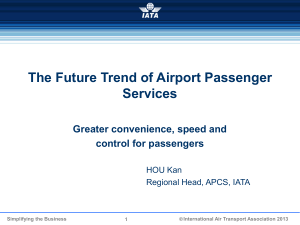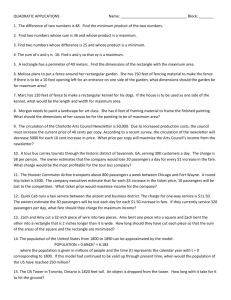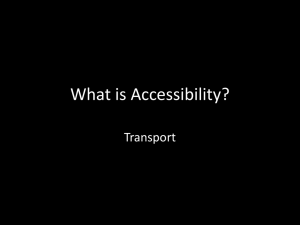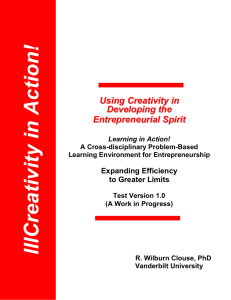Social Interaction Aboard Public Transportation
advertisement
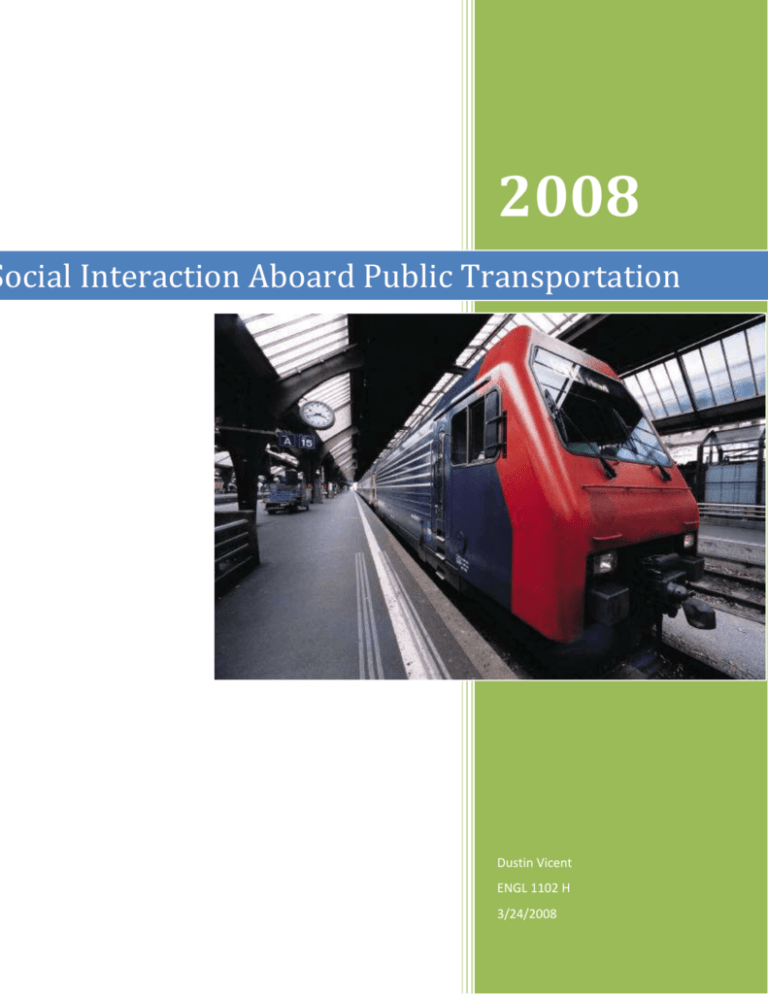
2008 Social Interaction Aboard Public Transportation Dustin Vicent ENGL 1102 H 3/24/2008 Abstract The interaction of people aboard public transportation is an intriguing subject. The purpose of this report was to draw conclusions about how passengers interact while riding on public transportation; in this case, the Valdosta State University Shuttle system. The method of observation was to ride along on the shuttle system for one hour, observing and recording any interactions or activities among the other passengers. The data collected led to several unexpected conclusions. Key Words: Public transportation, Social interaction, Valdosta State University Shuttle system, Demographics, Keitai. Introduction The public transportation system and the complexities of the interactions of people have been on the forefront of public opinion many times throughout history. The most impressive and memorable example for most is the stand by Rosa Parks and the Montgomery Bus Boycott during the Civil Rights Movement of the 1960’s. In this case, the public transportation system and the interaction of people merged to form one of the most controversial periods in our country’s history. Yet through the efforts of those involved in this movement, a completely new way of thinking about public transportation and the passengers who use it was created. Armed with the information gained from this investigation and the research compiled by leading authorities in the field of sociology and the public transportation system, this study aims to do nothing less. The Procedure To begin the observation, I watched the Valdosta State University Shuttle system for several days to determine at what time of day was the largest flow of passengers. Once this was determined, the next step was to become a passenger myself. Taking a seat in the very rear of the shuttle (in order to have the best vantage point of all the passengers), I took on the role as a typical passenger. During the observation, I remained detached from rest of the passengers; not speaking unless spoken to, not reacting to anything that was going on inside the shuttle. For exactly one hour, the actions and interactions of every passenger that boarded the shuttle were recorded for later interpretation and analysis. The Data By watching the VSU Shuttle system for the several days preceding the observation project, I concluded the most active flow of passengers was from approximately the 12:00 to 1:00 PM time frame. The hour of observation produced a plethora of data. During this period, a total of 116 passengers boarded the shuttle. Twelve stops were made during the allotted time during which there was a maximum boarding party of seventeen and a minimum of two. Of the 116, twenty one made or accepted a phone call at some point during transit; eight carried a conversation over the phone for the entirety of the shuttle transit. Seventy five passengers performed some activity with their cell phone; activities ranged from text messaging (vast majority), accessing the internet, to playing games. Fourteen read some form of text. Forty one spoke to another passenger; twelve continued a conversation during their ride aboard the shuttle. Many passengers performed multiple tasks, such as text messaging while speaking with another passenger. Nineteen passengers had no activity at all. 140 120 100 Total Passengers Talked on Cell 80 Activity with Cell 60 Read Spoke to Others 40 No Activity 20 0 Number of Passengers Outside Studies Several studies have been conducted by the leading authorities in the fields of public transportation and sociology concerning the benefits of the interactions of passengers aboard public transportation. Through multiple studies, PublicTransportation.org stated that “Public transportation…increases social interaction…and encourages social activities” (Facts). A study performed by Frank Goetzke of the University of Louisville concluded, “Positive network effects exist when people prefer to use transit together with other people as a result of social spill-over” (Goetzke). Both of these studies claim public transportation is beneficial to social welfare. Findings Through the observations of this study, it is clear that social interaction is a definite part of public transportation. Over 35% of the subjects in this test communicated to another passenger during the hour of observation. But it was the vast number of passengers operating a cell phone during the test period that was the most striking. Nearly 70% performed some type of cell phone activity during transit. The amount of cell phone usage doubled that of interpersonal communication. Study Limitations The foremost limitation in this study was the observation time of one hour. To get a better sample of data, longer or multiple observation periods should be utilized. The second limitation to this study was that of the localized area it was performed. The demographics of such a restricted region are too narrow to draw a definitive conclusion. Because the sociologic subject of this study is so broad, a larger test group of multiple locations nationwide would have to be implemented in order for this study to be conclusive on a large scale. Conclusion It is undeniable the findings of this study do to some degree support the position of the leading authorities in the fields concerning interaction of people aboard public transportation. Taking advantage of public transportation does seem to foster an ample amount of social interaction. But there was an unexpected observation that is responsible for the most relevant topic. The fact that cell phone usage was by far the most common activity aboard the Valdosta State University Shuttle system, doubling that of any social interaction, shows several things. First, the fast paced society that we now live in has essentially self-induced people’s increasing reliance upon new technology in the form of cellular devices. Second, the need…the desire of interpersonal communication in the form of simple conversation has decreased due to this dependence of real-time cellular communication. I theorize that if each passenger aboard that shuttle had not possessed any type of cellular device, the statistics of those who initiated conversation with a fellow passenger would have tripled. If public transportation is to continue to offer social interaction as one of its benefits, new rules for cellular usage while in transit must be made. In Japan, such actions have already been implemented. According to Japanese ordinance, keitai (mobile phone) usage in many public places, especially public transportation, is strictly prohibited. In Japanese culture, even speaking on a keitai in a public place is considered extremely rude (Okabe). There was a time here in our country when the same was true of our culture. When in America did the disturbance of cell phones in the confines of public transportation become acceptable? Perhaps it is when culture could not keep up with the no-holds-bar society we have chosen to be a part of. Regulate the excess of cell phone activity in transit, and social interaction will once again flourish aboard American public transportation. Works Cited Facts on Public Transportation. American Public Transportation Association. 19 Feb 2008. <http://www.publictransportation.org/facts/>. Goetzke, Frank. “Network Effects in Public Transit Use: Evidence from a Spatially Autoregressive Mode Choice Model for New York.” Urban Studies Journal Limited Vol. 45, No. 2 (2008): 407-417. Okabe, Daisuke, and Mizuko Ito. “Keitai in Public Transportation.” Japan Media Review 26 July 2006. 19 March 2008 <http://www.japanmediareview.com/japan/stories/060726okabeito/>.
